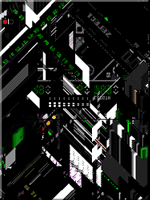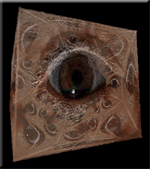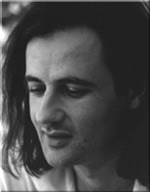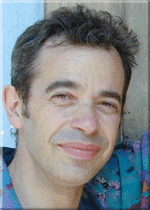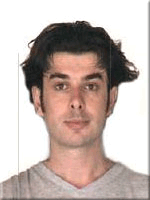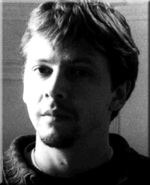|
|
|||
|
It was the light-heartedness and beauty of Nicolas Clauss’s interactive visual work, the simplicity and appropriateness of the sound Jean-Jacques Birgé created, and the synthesis that was achieved, that first drew my attention to the French artists included in Paris Connection. I interacted with Clauss’s works. I laughed. I had fun. Turbulence spotlighted Clauss’ work; I spoke with my students about him, and later, as I came to know the work of other members of this loosely knit Parisian group of artists, I spoke about them as well. The students’ response was similar to my own. There is a huge difference, a friend recently remarked, between learning and experiencing. What you get with these artists is an experience. And it’s easy. This, by the way, is a compliment. In a medium where work can so easily exhaust you with complications, overload you with information, take so much time to navigate that you end up, metaphorically at least, tearing your hair out in frustration, here are simple works that use the medium, are easily accessible and in which one can sense both the presence of the artists (still) and their human concerns. “Simple things are often beautiful! No?" (Durieu) Yes they are. Move from Clauss to Durieu and the "Oeil Complex": unencumbered with the knowledge of Platonic solids (see Andrews's review of "Oeil Complex") I encountered the eyes as a creature—something with unusual form but alive and giving expression to feeling, perhaps desperation, as Durieu suggests, perhaps fear and bewilderment as I experienced it. I’m easy. I want to experience art first, study it after. I felt something for this creature, just as I felt something (delight) for the wobbly-legged animals in Durieu’s and Birgé's zoo as my actions caused them to trip over themselves, get tied in knots, only to right themselves and regain their composure as independent semi-autonomous creatures when finally I left them alone. Or move to Schmitt’s darker, more minimal work, where the struggle of stick creatures in “Avec determination” strikes a human chord even before one understands that the programming work is inextricable from the work’s meaning—that these seemingly fragile semi-autonomous beings implemented in algorithms are forever confined to environments created for them and behaviors made possible within them. Stuck in this hopeless situation, they have the force of what Roberto Simanowski calls a double life—they are creatures caught in boxes and they are symbols, representing the viewer, who, momentarily in control, sends them crashing hopelessly against the limits of their environments with the simple movement of his mouse. Inclining more to the musical side, there’s Lamarque’s interactive visual music instrument, Pianographique—I’m not sure it’s important to resolve the question of whether it’s a work of art or a tool. It is one of a very few truly noteworthy interactive works online that combines music and image and is a pleasure to play with. And there’s servovalve ‘s work—minimal, set in a black background, its images in motion with its sound, both beautiful to watch and listen to. Try www.servovalve.org/2001/0621/0621.html ("ohon") or www.servovalve.org/2001/1028/1028.html ("electrotomy") Or www.servovalve.org/2003/0104/0104.html ("search: ubanizer--11"), a visually more complex work. It’s not hard to imagine performing with these programming-controlled transformations, as servovalve does. But it is also an absorbing experience to watch/listen, and be carried off into their mysterious, sometimes ominous, but always communicating worlds. Algorithmic poetry may very well be a good description for them all—if one takes poetry to be an all-encompassing term, rather than a division of literature. The mathematics—the programming—are at the service of the art, at the service of synthesis, at the service of human intelligible meaning and emotion. Actually inseparable from them. The “new profession of programming,” as Birgé calls it, is well served by all these artists. Nicolas Clauss speaks of his interest in the in-between. There is something of the in-between in all these works. Something that reminds me of Ann McCaffrey’s popular novels about dragon riders and wizards, where those who travel between universes travel without sight or hearing, but at the same time, “leave nothing behind.” In the way in which we talk about these six artists one can sense that we are in an in-between. We may not know what art will be in twenty or thirty years, but we can be sure we will not talk about it in the same way, any more than we now talk about performance art in terms of the discipline from which it emerged and those that contributed to its development. Right now we are still close to the time when painting, sound, motion belonged in separate identifiable categories and we speak of their synthesis as multimedia …But there is a merging, a transformation that the “new profession” makes possible–intermedia was the word Dick Higgins used. You can see it in these works. And they leave nothing behind.
|
|||
|
|||
